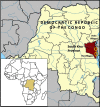Food Security and Nutrition Outcomes of Farmer Field Schools in Eastern Democratic Republic of the Congo
- PMID: 29284698
- PMCID: PMC5752609
- DOI: 10.9745/GHSP-D-17-00203
Food Security and Nutrition Outcomes of Farmer Field Schools in Eastern Democratic Republic of the Congo
Abstract
Background: Food and nutrition security in eastern Democratic Republic of the Congo are threatened by political instability and chronic poverty. The Jenga Jamaa II project, implemented between 2011 and 2016 in South Kivu Province, aimed to improve household food security and child nutritional status using various intervention strategies, including farmer field school (FFS) programs.
Objective: To characterize the changes in agricultural production techniques, household food security, and child nutritional status associated with participation in FFS programs.
Methods: We used a community-matched design to select FFS intervention and control households from 3 health zones in which the project was operating. Data on food security (Household Dietary Diversity Score [HDDS] and Household Food Insecurity Access Scale [HFIAS]) and child anthropometry were collected semiannually for 3.5 years in both groups. Additional data on agricultural practices were collected annually in the FFS group only. Focus groups with FFS staff and beneficiaries were conducted in the final project year. Statistical analyses included basic descriptive statistics such as paired t tests and analysis of covariance; regression models using a bootstrap were applied to generate P values and confidence intervals while accounting for differences between groups.
Results: The study enrolled 388 FFS beneficiaries and their households in the intervention group and 324 non-FFS households in the control group. FFS participants reported increasing the number of different agricultural techniques they used by an average of 2.7 techniques over the project period, from 5.1 in 2013 to 7.9 in 2016 (P<.001). The mean HDDS and HFIAS improved more in the FFS group than in the control group (mean difference between intervention and control for HDDS was 0.9 points and for HFIAS was -4.6 points; P<.001). However, the prevalence of child stunting (60.2% intervention vs. 58.8% control) and underweight (22.3% intervention vs. 29.8% control) were similar in both groups at endline (P>.05).
Conclusion: Although FFS participants diversified their agricultural production strategies and experienced improvements in household food security, there was not a positive impact on child nutritional status. In this food-insecure context, improvements in agricultural production alone are unlikely to significantly change child nutritional status-a health outcome with a complex, multilevel causal chain.
© Doocy et al.
Figures

References
-
- Coghlan B, Ngoy P, Mulumba F, et al. Mortality in the Democratic Republic of Congo: An Ongoing Crisis. New York, NY: International Rescue Committee; 2007. https://www.rescue.org/sites/default/files/document/661/2006-7congomorta... Accessed February 9, 2017.
-
- Democratic Republic of the Congo. World Food Programme website. http://www1.wfp.org/countries/democratic-republic-congo. Published 2017 Accessed March 16, 2017.
-
- U.S. Agency for International Development (USAID). USAID Office of Food for Peace Food Security Desk Review for Katanga, North Kivu, and South Kivu, Democratic Republic of Congo. Washington, DC: FHI 360/FANTA; 2015. https://www.fantaproject.org/sites/default/files/resources/FFP-Kivu-Kata... Accessed October 13, 2017.
-
- World Food Programme, International Food Policy Research Institute, Democratic Republic of Congo. Comprehensive Food Security and Vulnerability Analysis (CFSVA): Democratic Republic of Congo. Rome, Italy: World Food Programme; 2014. http://documents.wfp.org/stellent/groups/public/documents/ena/wfp266329.... Accessed January 10, 2017.
Publication types
MeSH terms
LinkOut - more resources
Full Text Sources
Other Literature Sources
Medical
